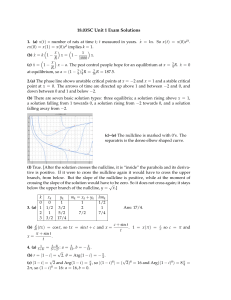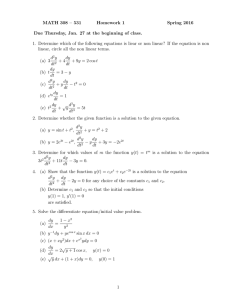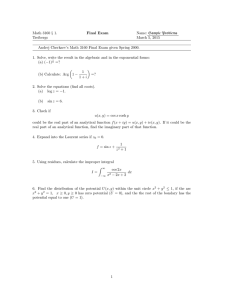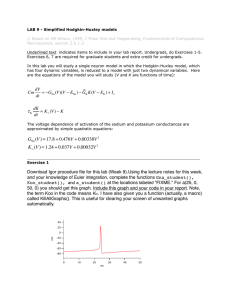Document 13559455
advertisement
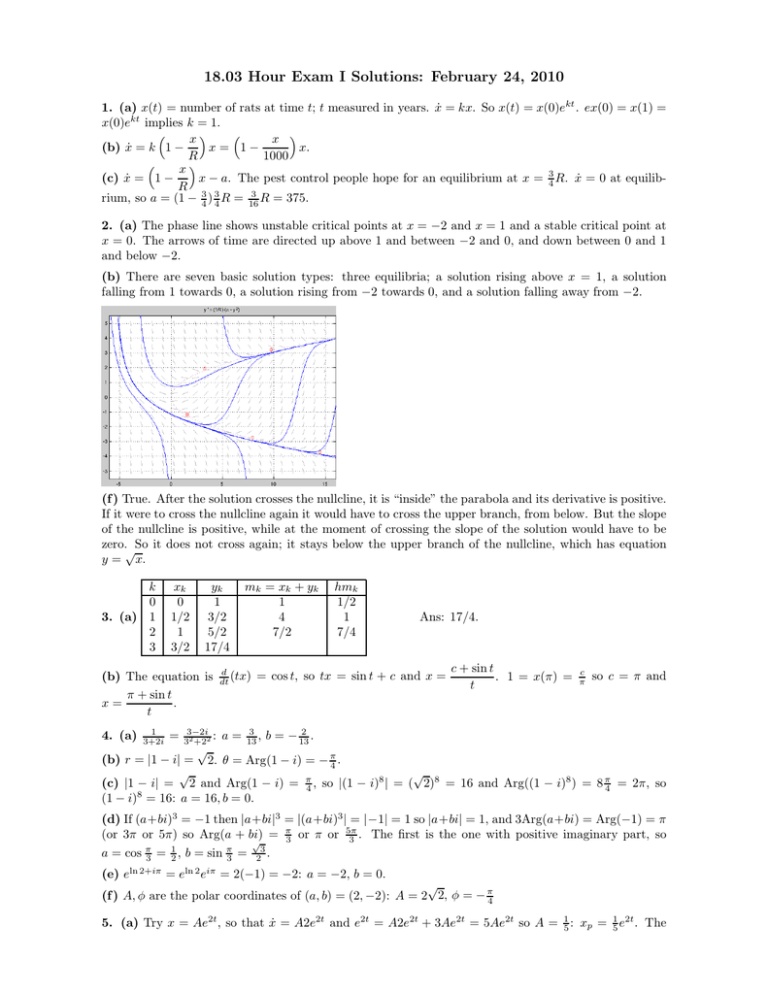
18.03 Hour Exam I Solutions: February 24, 2010 1. (a) x(t) = number of rats at time t; t measured in years. ẋ = kx. So x(t) = x(0)ekt . ex(0) = x(1) = x(0)ekt implies k = 1. � � x � x� x= 1− x. (b) ẋ = k 1 − R 1000 � � x (c) ẋ = 1 − x − a. The pest control people hope for an equilibrium at x = 43 R. ẋ = 0 at equilib­ R 3 rium, so a = (1 − 34 ) 34R = 16 R = 375. 2. (a) The phase line shows unstable critical points at x = −2 and x = 1 and a stable critical point at x = 0. The arrows of time are directed up above 1 and between −2 and 0, and down between 0 and 1 and below −2. (b) There are seven basic solution types: three equilibria; a solution rising above x = 1, a solution falling from 1 towards 0, a solution rising from −2 towards 0, and a solution falling away from −2. (f ) True. After the solution crosses the nullcline, it is “inside” the parabola and its derivative is positive. If it were to cross the nullcline again it would have to cross the upper branch, from below. But the slope of the nullcline is positive, while at the moment of crossing the slope of the solution would have to be zero.√So it does not cross again; it stays below the upper branch of the nullcline, which has equation y = x. k 0 3. (a) 1 2 3 xk 0 1/2 1 3/2 yk 1 3/2 5/2 17/4 (b) The equation is π + sin t x= . t 4. (a) 1 3+2i = 3−2i 32 +22 : mk = xk + yk 1 4 7/2 d dt (tx) a= hmk 1/2 1 7/4 Ans: 17/4. = cos t, so tx = sin t + c and x = 3 13 , c + sin t . 1 = x(π) = t c π so c = π and 2 b = − 13 . √ (b) r = |1 − i| = 2. θ = Arg(1 − i) = − π4 . √ √ (c) |1 − i| = 2 and Arg(1 − i) = π4 , so |(1 − i)8 | = ( 2)8 = 16 and Arg((1 − i)8 ) = 8 π4 = 2π, so (1 − i)8 = 16: a = 16, b = 0. (d) If (a+bi)3 = −1 then |a+bi|3 = |(a+bi)3 | = |−1| = 1 so |a+bi| = 1, and 3Arg(a+bi) = Arg(−1) = π (or 3π or 5π) so Arg(a + bi) = π3 or π or 5π 3 . The first is the one with positive imaginary part, so √ a = cos π3 = 12 , b = sin π3 = 23 . (e) eln 2+iπ = eln 2 eiπ = 2(−1) = −2: a = −2, b = 0. √ (f ) A, φ are the polar coordinates of (a, b) = (2, −2): A = 2 2, φ = − π4 5. (a) Try x = Ae2t , so that ẋ = A2e2t and e2t = A2e2t + 3Ae2t = 5Ae2t so A = 15 : xp = 15 e2t . The transient is ce−3t , so x = 51 e2t + ce−3t is a valid solution for any c as well. 1 5 2it (b) 1 = x(0) = (c) ż + 3z = e + c implies c = 54 : this particular solution is x = 15 e2t + 45 e−3t . 1 (d) Try z = Ae : ż = A2ie2it , so e2it = ż + 3z = A(3 + 2i)e2it . This gives A = 3+2i and solution 1 3−2i 3 2 2it zp = 3+2i e = 13 (cos(2t) + i sin(2t)), which has real part xp = 13 cos(2t) + 13 sin(2t). 2it MIT OpenCourseWare http://ocw.mit.edu 18.03 Differential Equations���� Spring 2010 For information about citing these materials or our Terms of Use, visit: http://ocw.mit.edu/terms.
